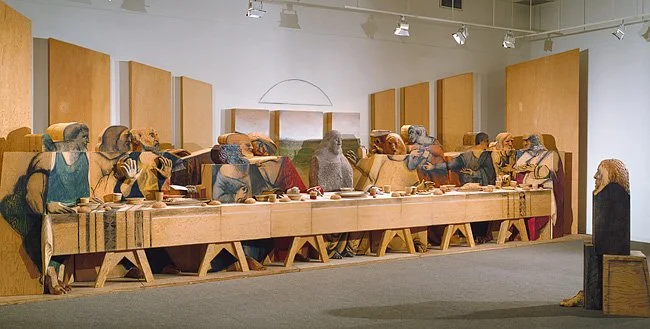Breaking Bread (and the Fourth Wall)
How Visual Art Challenges our Closeness to God during Lent
This article is part of the blog’s Lent series where Claritas writers are reflecting on the season of Lent in the weeks leading up to Easter.
BY ESTELLE HOOPER
Like many others seeking comfort in a pandemic-stricken world, I’ve been rewatching my favorite childhood shows to reminisce about a less stressful time in my life. Last month, while watching the Nickelodeon sitcom Victorious, I was struck by a joke that I missed as a kid but caught with my now-slightly-smarter adult brain. During a lunch conversation in Season 2 Episode 10 (“Tori Tortures Teacher”), Andre Harris asks his friends, “How come none of us ever sit on that side of the table?” A laugh track then plays as the actors’ eyes slowly pan to the empty side of the table across from them. The directors of Victorious were attempting to break the “fourth wall,” or the invisible boundary between the story and reality. In the show’s universe, the characters don’t understand why they are seated awkwardly, but as viewers, we know that these empty spaces are necessary for dialogue that can push the story forward.
The fourth wall exists in media to define the boundary between the subject and the viewer. But, in the story of the Bible, we are not viewers but participants in God’s plan for redemption. During the season of Lent, Christians will set aside time to intentionally focus on God, and it will often come in the consumption of media. Christian Renaissance paintings, The Prince of Egypt, and worship music all serve as examples of creative expressions of God’s word that Christians relate to—because of our inability to fully comprehend God as a Creator, and because we desire to understand our place within God’s story for humankind.
Beyond creative expression, our understanding of God is often revealed to us through narrative. Jesus often taught in parables, or simple stories with moral or spiritual lessons, to analogize the Kingdom of God. In the middle of Paul’s explanation of salvation, he reminds the Romans, “I am using an example from everyday life because of your human limitations.” [1] While Paul’s simplification of Jesus’s death has already appealed to the Romans (and by extension, readers of the Bible), God’s design of it is much greater.
Fig. 1 Leonardo da Vinci. The Last Supper. 1498.
In the same way that we use creative expression and storytelling to understand the Gospel, I like to reflect on visual art to better understand the distance between our vision of God and His vision for us. In Leonardo da Vinci’s famous painting The Last Supper (1498) (Fig. 1), Jesus is sharing his last meal with his disciples on the same side of the table. Like the Victorious lunch scene, da Vinci approached seating this way so that viewers could see everyone’s faces in the same frame. However, when we think about how we actually sit at meals with our friends and families, we don’t sit like we’re being filmed. In the Gospel of Luke’s account of the Last Supper, Jesus declares to his disciples, “I have eagerly desired to eat this Passover with you before I suffer.” [2] With such an outright admission of longing from the Son of God, it doesn’t make sense for the disciples to not face Jesus when he is speaking to them.
Fig 2. Marisol Escobar. Self-Portrait Looking at the Last Supper. 1982-1984.
Marisol Escobar reconciles with the awkwardness of da Vinci’s painting in her sculpture installation, Self-Portrait Looking at The Last Supper (1982–84) (Fig. 2). She recreates his scene and figures three-dimensionally, giving observers a chance to feel like a dinner guest at the half-empty table, rather than a watcher of the event. Despite this opportunity to fill the empty space, Escobar decides to not participate in the last supper. Across from Jesus and his disciples is a sculpture of Escobar herself, located close enough to watch, but still too far to join.
I don’t know why Escobar’s sculpture is so far from Jesus, but I resonate with the idea of feeling distant to him. During this self-reflective season of Lent, I’ll try to close this metaphorical distance. I’ll chip away at the various “fourth walls” that prevent me from dining with Jesus, such as my lack of knowledge about God and the shame of my shortcomings. When Jesus died with our sin, he broke those obstacles we built for ourselves—and because he rose to life again, I can rejoice in the fact that he has already done the work to invite me to his table.
Fun fact: Leonardo da Vinci’s 1498 Last Supper painting is the most reproduced and satirized religious artwork of all time. Browse through the following slideshow to see some of my favorites!
SOURCES
Romans 6:19, NIV
Luke 22:15, ESV
Leonardo da Vinci. The Last Supper. 1498. https://www.britannica.com/topic/Last-Supper-fresco-by-Leonardo-da-Vinci
Marisol Escobar. Self-Portrait Looking at the Last Supper. 1982-1984. https://www.metmuseum.org/art/collection/search/484650
Peter Paul Rubens. Last Supper. 1630-1631. https://en.wikipedia.org/wiki/Last_Supper_(Rubens)
Mary Beth Edelson. Some Living American Women Artists. 1972. https://www.moma.org/collection/works/117141
Andy Warhol. The Last Supper (pink). 1986. https://www.artimage.org.uk/10064/andy-warhol/the-last-supper--1986
Andy Warhol. The Last Supper. 1986. https://www.invasionidigitali.it/andy-warhol-in-mostra-al-vaticano/
Adi Nes. The Last Supper. 2007. https://www.widewalls.ch/magazine/adi-nes








